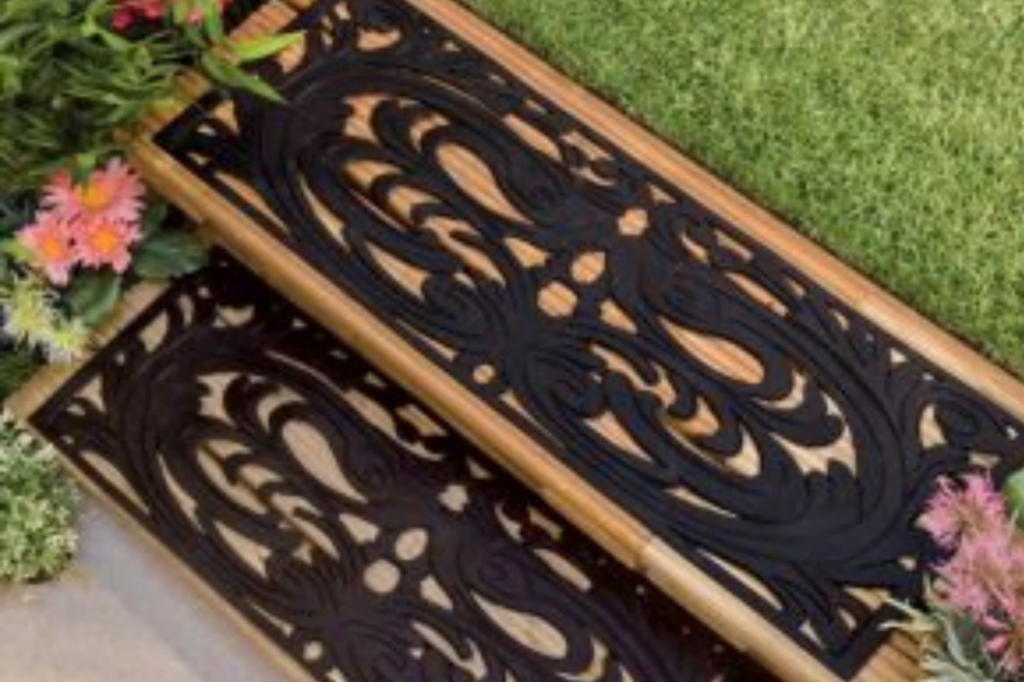Do you have outdoor wooden steps that can become slippery and dangerous, especially during wet or icy conditions? If so, it’s important to make them non-slip to ensure your safety and prevent accidents.
In this article, we will guide you on how to make your outdoor wooden steps non-slip.
First, you need to assess the condition of your wooden steps to identify any areas that may need repair or replacement.
Then, thoroughly clean the steps to remove any dirt or debris that can make them slippery.
Next, apply an anti-slip coating to provide traction and improve grip.
You can also consider using non-slip treads or stair mats for added safety.
To further enhance safety, install handrails for better support while climbing up or down the steps.
Additionally, outdoor lighting can improve visibility and prevent accidents, especially during nighttime.
Remember to regularly maintain and repair your wooden steps to ensure their longevity and safety.
Lastly, consider using alternative materials for your steps, such as composite or rubber, which offer better slip resistance.
By following these steps and taking necessary precautions, you can transform your outdoor wooden steps into a safe and secure pathway.
Quick Summary
- Assess and repair or replace damaged areas of wooden steps.
- Thoroughly clean steps to remove dirt and debris.
- Apply anti-slip coating for traction and improved grip.
- Consider using non-slip treads or stair mats.
Assess the Condition of Your Wooden Steps
Take a quick look at your wooden steps to see how they’re holding up, so you can get started on making them slip-free in no time! Safety should always be a priority when it comes to outdoor wooden steps.
To ensure the safety of you and your loved ones, it’s important to assess the condition of your steps and take appropriate actions to repair any damage. Begin by inspecting each step carefully. Look for signs of wear and tear, such as cracks, splinters, or loose boards. Repair any damaged steps by replacing or repairing the affected areas. This will not only enhance the appearance of your steps but also prevent accidents caused by unstable surfaces.
In addition to repairing any damage, applying an anti-slip coating is crucial to making your wooden steps safe and slip-resistant. There are various types of anti-slip coatings available, so it’s essential to choose the right one for your specific needs. Look for coatings that are designed for outdoor use and provide a strong grip even in wet conditions. Consider factors such as durability, ease of application, and long-lasting effectiveness when selecting the coating.
By assessing the condition of your wooden steps and choosing the right anti-slip coating, you can ensure that your outdoor steps are safe and slip-free for everyone to use. Don’t wait any longer, take action now to make your wooden steps a secure pathway.
Clean Your Wooden Steps
Start by ensuring that your wooden steps are spotless, so you can confidently tread without any worries. Regular cleaning is essential for wooden steps maintenance and preventing mold and mildew growth.
Here’s a simple 3-step process to keep your outdoor wooden steps clean and safe:
- Sweep away debris: Begin by sweeping the steps with a broom to remove any dirt, leaves, or other debris. Pay extra attention to the corners and edges where debris tends to accumulate.
- Scrub with a solution: Mix a solution of warm water and mild detergent. Dip a scrub brush into the solution and gently scrub the wooden steps, working in small sections. This will help remove any built-up grime and stains. Avoid using abrasive cleaners or brushes that could damage the wood.
- Rinse and dry: After scrubbing, rinse the steps thoroughly with a hose or bucket of clean water. Make sure to remove all soap residue. Finally, allow the steps to air dry completely before using them again.
By following these steps regularly, you can maintain clean and safe wooden steps, free from slippery hazards and the growth of mold and mildew.
Apply an Anti-Slip Coating
Ensure your wooden steps are safe and secure by applying an anti-slip coating, keeping you confident and worry-free as you tread. Choosing the right anti-slip coating is crucial to achieve the desired level of safety. There are various options available in the market, each with its own unique features. Consider factors such as durability, ease of application, and effectiveness in providing traction.
One popular choice is non-slip paint, specifically designed to add an extra layer of safety to your outdoor wooden steps. This type of coating is formulated with special additives that create a textured surface, enhancing grip and preventing slips and falls. Non-slip paint is available in different colors, allowing you to customize the look of your steps while prioritizing safety.
To further illustrate the importance of applying an anti-slip coating, take a look at the table below:
| Coating Type | Durability | Ease of Application | Traction |
|---|---|---|---|
| Non-slip paint | High | Easy | Excellent |
| Other coating options | Varies | Varies | Varies |
Using non-slip paint for added safety ensures that your wooden steps remain slip-resistant, even during wet or icy conditions. By taking this simple step, you can enjoy your outdoor space with peace of mind, knowing that you have taken measures to protect yourself and others from potential accidents.
Use Non-Slip Treads or Stair Mats
By utilizing non-slip treads or stair mats, you can enhance the safety and security of your outdoor staircase. These simple yet effective solutions provide a reliable grip, ensuring that you and your loved ones can navigate the steps with confidence.
Here are four reasons why non-slip treads or stair mats are a must-have for your outdoor wooden steps:
- Easy Installation: Non-slip treads or stair mats are simple to install and don’t require any special tools or skills. You can easily attach them to your wooden steps using adhesive or screws.
- Durability: Made from high-quality materials, these treads or mats are designed to withstand outdoor elements and heavy foot traffic. They are built to last, providing long-term protection for your stairs.
- Low Maintenance: Non-slip treads or stair mats are easy to clean and maintain. With regular sweeping and occasional use of cleaning products specifically designed for non-slip surfaces, you can keep them in top condition.
- DIY Solutions: Installing non-slip treads or stair mats is a great do-it-yourself project that can be completed in no time. It’s a cost-effective way to improve the safety of your outdoor steps without the need for professional assistance.
Investing in non-slip treads or stair mats is a smart choice for anyone looking to make their outdoor wooden steps safer. With their easy installation, durability, low maintenance, and DIY nature, these solutions provide peace of mind while adding an extra layer of protection to your stairs.
Install Handrails for Added Support
Boost the safety of your outdoor staircase by installing handrails, providing essential support for navigating the steps with confidence. Proper handrail installation is crucial to prevent accidents and ensure the safety of everyone using the stairs. There are several types of handrails available that are suitable for outdoor wooden steps.
One common option is the wooden handrail, which blends seamlessly with the natural look of the wooden steps. It provides a sturdy grip and enhances the overall aesthetic appeal of your outdoor staircase. Another popular choice is the metal handrail, which offers durability and a sleek, modern look. Metal handrails can withstand harsh weather conditions and require minimal maintenance.
In addition to wooden and metal handrails, there are also handrails made of PVC or composite materials. These options are resistant to rot, mold, and insects, making them ideal for outdoor use. They are also available in various colors and styles, allowing you to customize the look of your staircase.
When installing handrails, make sure they are securely attached to the steps and provide a comfortable grip. Consider the height and spacing requirements to ensure they meet safety standards. By choosing the appropriate handrail and installing it correctly, you can greatly enhance the safety of your outdoor wooden steps and provide peace of mind for yourself and your loved ones.
| Handrail Type | Benefits | |||
|---|---|---|---|---|
| Wooden Handrail | Blends with natural look, provides sturdy grip | |||
| Metal Handrail | Durable, modern appearance, low maintenance | |||
| PVC/Composite Handrail | Rot and insect resistant, customizable colors and styles | Plastic Handrail | Affordable, lightweight, easy to install and clean | |
| Glass Handrail | Sleek and contemporary, allows for unobstructed views | |||
| Wrought Iron Handrail | Elegant and decorative, adds a touch of sophistication | |||
| Stainless Steel Handrail | Corrosion resistant, sleek and modern appearance | |||
| Rope Handrail | Unique and rustic look, adds a nautical touch | |||
| Brass Handrail | Classic and timeless, adds a touch of luxury | |||
| Concrete Handrail | Extremely durable, perfect for outdoor use | |||
| Acrylic Handrail | Transparent and modern, adds a minimalist touch | |||
| Bamboo Handrail | Eco-friendly, exotic and natural look | |||
| Leather Handrail | Luxurious and comfortable grip, adds a unique texture | |||
| Stone Handrail | High-end and luxurious, adds a touch of grandeur | |||
| Ceramic Handrail | High resistance to wear and tear, adds a decorative element | |||
| Resin Handrail | Versatile and customizable, can mimic the look of other materials | |||
| Rope Handrail | Affordable and easy to install, adds a rustic touch | |||
| Vinyl Handrail | Low maintenance, resistant to fading and discoloration | |||
| Rubber Handrail | Shock-absorbent, provides a soft and comfortable grip | |||
| Mosaic Handrail | Artistic and colorful, adds a unique element to the space | |||
| Wire Handrail | Sleek and minimalist, adds an industrial touch | |||
| Teak Handrail | Resistant to moisture and decay, ideal for outdoor use | |||
| Tile Handrail | Durable and easy to clean, can be customized with various patterns | |||
| Plastic-coated Handrail | Provides a non-slip grip, resistant to weather conditions | |||
| Carbon Fiber Handrail | Lightweight and strong, adds a modern and high-tech touch | |||
| Rope Net Handrail | Unique and decorative, adds a playful element to the space | |||
| Cork Handrail | Eco-friendly and sustainable, provides a soft and warm grip | |||
| Fabric Handrail | Soft and comfortable grip, adds a cozy touch | |||
| Painted Handrail | Customizable with various colors and patterns, adds a personal touch | |||
| Walnut Handrail | Rich and elegant appearance, adds a touch of luxury | |||
| LED Handrail | Provides ambient lighting, adds a modern and futuristic touch | |||
| Cork Handrail | Eco-friendly and sustainable, provides a soft and warm grip | |||
| Fabric Handrail | Soft and comfortable grip, adds a cozy touch | |||
| Painted Handrail | Customizable with various colors and patterns, adds a personal touch | |||
| Walnut Handrail | Rich and elegant appearance, adds a touch of luxury | |||
| LED Handrail | Provides ambient lighting, adds a modern and futuristic touch | |||
| Cork Handrail | Eco-friendly and sustainable, provides a soft and warm grip | |||
| Fabric Handrail | Soft and comfortable grip, adds a cozy touch | |||
| Painted Handrail | Customizable with various colors and patterns, adds a personal touch | |||
| Walnut Handrail | Rich and elegant appearance, adds a touch of luxury | |||
| LED Handrail | Provides ambient lighting, adds a modern and futuristic touch |
Add Outdoor Lighting for Better Visibility
Illuminate your outdoor staircase with outdoor lighting to improve visibility and create a safer environment for navigating the steps. When it comes to making your wooden steps non-slip, adding outdoor lighting is a crucial step.
Here are three reasons why you should consider incorporating outdoor lighting into your staircase:
- Improve Landscaping: Outdoor lighting not only enhances the beauty of your outdoor space but also improves the overall landscaping. By strategically placing lights along your wooden steps, you can highlight the architectural features of your staircase, making it visually appealing and blending it seamlessly with the surrounding landscape.
- Enhanced Visibility: Proper lighting ensures that your outdoor staircase is well-lit, making it easier for you to see each step and avoid any potential hazards. Whether it’s during the day or at night, having well-lit steps provides better visibility, reducing the risk of accidents and slips.
- Reflective Markers: To further enhance visibility, consider using reflective markers on the edges of each step. These markers will reflect light, making the steps more visible even in low light conditions. This additional safety measure will help guide you and others safely up and down the stairs.
By incorporating outdoor lighting and using reflective markers, you can significantly improve the safety and visibility of your outdoor wooden steps. So, why wait? Illuminate your outdoor staircase today and create a safer environment for everyone.
Regularly Maintain and Repair Your Wooden Steps
Ensure the longevity and safety of your outdoor staircase by regularly maintaining and repairing the wooden steps. Wooden steps restoration is essential to prevent wood rot and maintain a sturdy and non-slip surface. By following these simple steps, you can keep your outdoor wooden steps in excellent condition.
First, inspect your steps regularly for any signs of damage or wear. Look for cracks, splinters, or loose boards. If you notice any issues, address them promptly to prevent further damage and potential accidents. Sand down any rough areas and replace any damaged boards to maintain a smooth and safe walking surface.
Next, apply a protective sealant or stain to your wooden steps. This will help to prevent moisture from seeping into the wood, which can lead to rotting. Choose a sealant that’s specifically designed for outdoor use and apply it according to the manufacturer’s instructions.
In addition to regular maintenance, it’s important to address any repairs as soon as they arise. Secure loose handrails, tighten screws, and replace any damaged or rotted boards. By promptly addressing these issues, you can ensure the safety and longevity of your wooden steps.
Regularly maintaining and repairing your outdoor wooden steps is crucial for preventing wood rot and ensuring the safety of those who use them. By taking these simple steps, you can enjoy a sturdy and non-slip surface for years to come.
Consider Alternative Materials for Your Steps
Using alternative materials for your steps can provide a durable and stylish solution for your outdoor staircase. When it comes to making your wooden steps non-slip, considering alternative materials can offer numerous benefits.
One option to consider is using rubber or non-slip treads. These treads are designed to provide excellent traction, ensuring that you and your loved ones can safely navigate the steps, even when they are wet or covered in snow. Additionally, rubber treads are easy to install and can be trimmed to fit your specific step dimensions.
Another alternative material to consider is using non-slip paint or coatings. These products can be applied directly to the wooden steps, creating a textured surface that enhances grip and reduces the risk of slipping. They are available in a variety of colors, allowing you to choose a finish that complements your outdoor aesthetic.
By opting for alternative materials with non-slip surfaces, you can enjoy the benefits of a safer staircase while maintaining the beauty of your outdoor space.
Frequently Asked Questions
How long does it take for the anti-slip coating to dry?
The drying time of the anti-slip coating depends on the specific product you choose. Follow the application process carefully and ensure the steps are completely dry before using them to ensure maximum safety.
Can I use regular household cleaners to clean my wooden steps?
To ensure the safety of your outdoor wooden steps, it’s best to avoid using regular household cleaners as they may not effectively remove dirt and grime. Instead, consider using specialized cleaning products or alternative methods specifically designed for wood surfaces.
Are non-slip treads or stair mats suitable for all types of wooden steps?
Non-slip treads or stair mats are suitable for most types of wooden steps, providing added safety. However, if you prefer alternatives, non-slip paint can also be used to make your outdoor wooden steps slip-resistant.
What are the recommended materials for outdoor handrails?
For outdoor handrails, the recommended materials include aluminum, wrought iron, and stainless steel. Aluminum is lightweight and low maintenance, while wrought iron offers classic beauty. Stainless steel is durable and resistant to corrosion. Consider your specific needs and budget when choosing.
How often should I inspect and maintain my wooden steps?
To ensure safety, inspect and maintain your wooden steps regularly. Check for any loose boards, cracks, or signs of wear and tear. Make necessary repairs promptly and consider applying a non-slip treatment to prevent accidents.
Conclusion
In conclusion, making outdoor wooden steps non-slip is crucial for safety and preventing accidents. By assessing the condition of your steps, cleaning them regularly, and applying an anti-slip coating, you can significantly reduce the risk of slipping and falling.
Additionally, using non-slip treads or stair mats, installing handrails, adding outdoor lighting, and regularly maintaining and repairing your steps are all effective strategies. If necessary, consider using alternative materials for your steps to further enhance their safety.
Keep these tips in mind and enjoy safer outdoor stairs!











